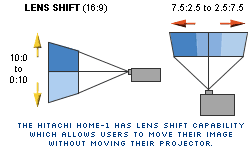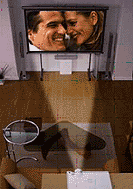Projector Lens Shift
Lens shift is a great feature for a conference room or home theater projector because it provides greater installation flexibility. What's so great about installation flexibility? It means that do-it-yourself home theater and business projector installers can spend less time on the mathematics of installation, and more time enjoying their new projector.
What is Lens Shift?
Lens shift provides space to move the lens itself left and right or up and down within the projector housing. This adjustment can be made either manually with a dial or joystick, or mechanically using the menu buttons. This extra space to reposition the lens means greater leeway in the placement of a projector in a room.

For example, imagine looking at a picture on your wall. Now imagine your picture moving up or down so that the top of the image is now located where the center of the image used to be. A projector with lens shift can make an adjustment like this without requiring you to physically move the projector. Rather, the lens inside the projector housing is moving to create the effect. Some projectors, like the Hitachi HOME-1, feature a wider flexibility allowing you to move the image almost twice as far. The HOME-1's lens shift has the most dramatic lens shift in and entry level home theater projector.
Keystone Correction Versus Lens Shift
Digital Keystone Correction is a great feature for power presenters. However, using lens shift to correct an image will produce better looking images. Why? Because when you use digital keystone correction, the image undergoes a compression and conversion that recreates edge pixels, sometimes causing noticeable artifacts along the corrected portion of the image. Keystone correction works well with still images, and well enough with video in a temporary setting. In a permanent installation, using lens shift will produce the best images.
Looking for a projector? Click here or call (888) 248-0675
Types of Lens Shift
There are many different kinds of lens shift. Some projectors can perform one kind of shift, most often vertical, while other projectors offer a broader range of motion including vertical, horizontal, and variable (diagonal) movement. Some projectors include a manual lens shift while others feature power adjustment.
Home Theater Conundrum
Customers who purchase and install a screen or mount before purchasing their projector often find themselves in a conundrum. They find they have limited choices in the projectors that fit their needs, because they need to fit a specific image size from a specific distance called the throw distance. That's why Projector People recommends that you purchase your projector, and possibly your ceiling mount, before buying your screen. If you have already installed your screen before buying your projector, a projector with lens shift such as the Hitachi HOME-1 may be the best solution for you.

